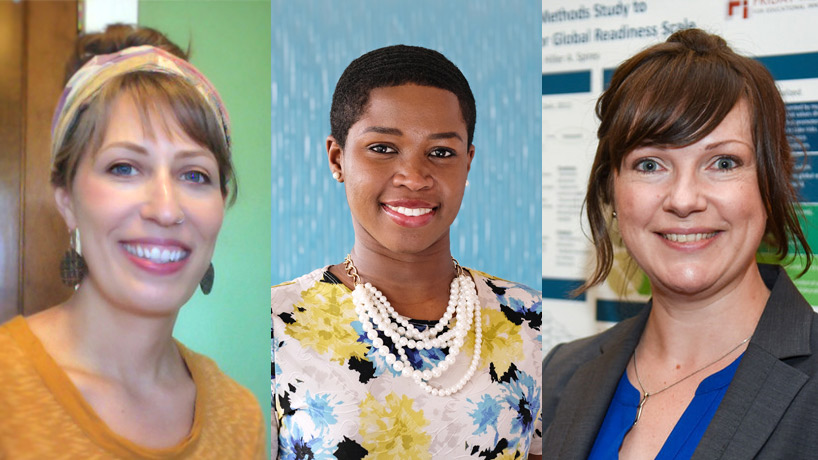
Jennifer Bumble (from left), Mary Edwin and Shea Kerkhoff discussed the impact of COVID-19 on children’s learning and social skills and offered strategies to meet students’ needs in the fall term. (Photos by August Jennewein)
Chloe enjoyed going to second grade. She loved her teacher and looked forward to playing with her friends at recess. She was learning how to multiply and had just read her first chapter book. The seed she planted for science class was sprouting leaves.
But when COVID-19 hit, Chloe’s school switched to remote learning. Instead of playing with her friends, she usually spent her days feeling bored. Her teacher posted video lessons, but because Chloe and her two siblings shared a cellphone, there wasn’t enough data to watch them all. Without guidance, reading was difficult so Chloe turned to other interests.
For school-age children, the coronavirus pandemic means decreased learning and less social interaction with peers. On Friday, Assistant Professors Jennifer Bumble, Mary Edwin and Shea Kerkhoff of the University of Missouri–St. Louis College of Education addressed how these issues impact students and how educators and schools can adapt to best meet students’ needs.
Their presentation was part of UMSL’s COVID-19 Research Conversations series sponsored by the Office of Research Administration. The conversations bring together faculty across disciplines to discuss opportunities for research related to the pandemic. More than 30 faculty members attended Friday’s discussion via Zoom.
The switch to remote learning was especially difficult for families who rely on schools to provide food and access to health services. Academically, education experts are concerned about a “COVID slide” that results in students falling as much as a year behind in math and reading.
In areas where internet access is lacking, the COVID slide is expected to be even more prominent. In St. Louis, the digital divide lies along Delmar Boulevard, and 44 percent of residents who live north of Delmar do not have internet access.
“It’s not as much the infrastructure as the affordability,” Kerkhoff said. “As well as a divide between access to the internet, there’s also access to high-speed internet or some people may access the internet through cell data but they only have so much data a month. They may have access to the internet, but they may not have access to the high-speed internet needed for streaming videos that teachers are posting for remote learning or they may not have enough data for all of the children to do their schoolwork.”
Even when students can access the internet, online platforms are not always user-friendly or accessible for students with disabilities. For instance, captioning is not available on all videoconferencing platforms, which can present a barrier to learning.
During the pandemic, families have had to focus on physiological and safety needs – ensuring children have food and shelter and are not exposed to COVID-19. Friendship with peers and a sense of connection with the community have not been priorities.
When students return to school, social distancing will limit activities like playing with other students and sharing toys.
“We are likely to see academic, social and emotional regression from schools being closed and from the loss of the way of life the students have gotten used to,” Edwin said. “You will be seeing that trauma impact children’s brains – the way they think, the way they interact, the way they communicate.”
Children may exhibit irritability and anger due to stress. The potential for trauma is especially high for children whose families face substance use, domestic violence, housing insecurity, food insecurity and more.
Bumble stressed that schools should carefully consider how to best support students who have disabilities.
“Many students with disabilities might not understand why they can’t be at school or have trouble with these new routines,” she said. “These are vulnerable populations, and we have to think through how to keep them safe. They’re at high risk for COVID-19, particularly students with more significant disabilities. It’s really important for schools to think through how to provide these services in a safe way.”
The webinar concluded with a discussion of possible ways for schools to keep students safe while optimizing learning. Participants explored the idea of schools opening year-round with shorter, more frequent breaks.
“It gives an opportunity for us to think about what’s best for learning rather than ‘What have we always done?’” Kerkhoff said. “If you think about our academic calendar, it’s based on an agrarian society. We needed the summers off so we could work in the fields. It’s not really needed anymore. We know that having that much time off isn’t good for learning. Here’s a chance to be innovative.”
The next COVID-19 Research Conversation will take place on June 26. Dan Lauer, founding executive director of UMSL Accelerate, will present “How COVID-19 Is Affecting Entrepreneurs and Small Business Owners in the St. Louis Region.”














